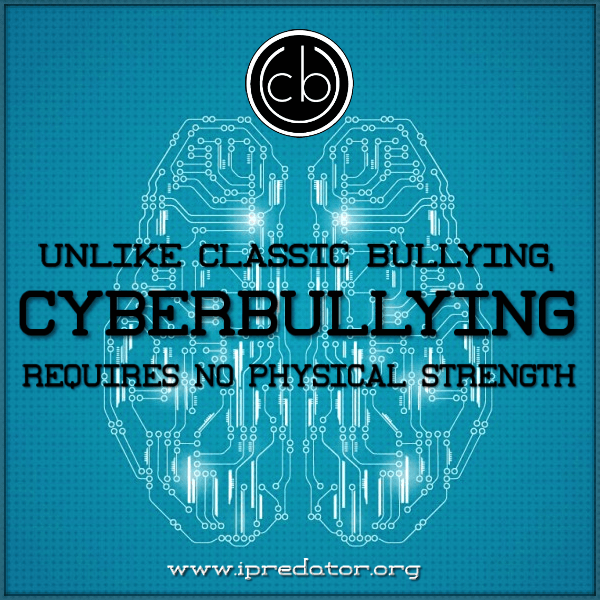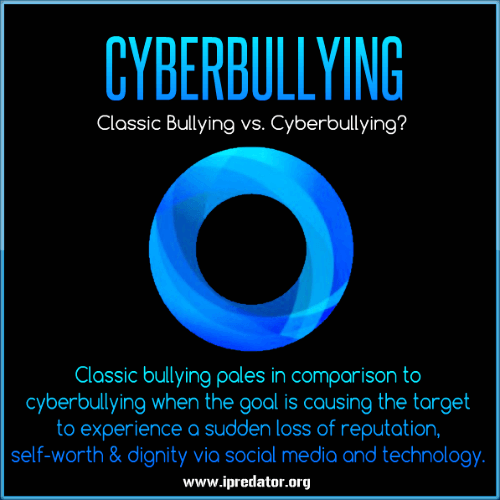The Cyberbullying Triad is a term used to describe the three typologies of children that engage in harming other children using Information and Communications Technology (ICT). This writer’s terms used to categorize cyber bullies include the Ignorant Cyberbully, Righteous Cyberbully and Narcissistic Cyberbully. Of the three profiles, the Narcissistic Cyberbully is the most problematic having the highest probability of engaging in malevolent and nefarious online activities as an adult.
Cyberbullying Triad
and
Three Types of Cyberbully
Cyberbullying Triad: Cyberbullying is the use of Information and Communications Technology between minors to humiliate, taunt and disparage one another. Cyberbullying is intended to tease, embarrass, deprecate & defame a targeted minor with the assailant’s developmental needs for peer acceptance and recognition being a priori. Dissimilar to physical bullying, cyberbullying does not involve face-to-face contact and primarily occurs online using electronic devices as the tools for information dissemination.
After spending an exhaustive amount of time investigating Cyberbullying, Bullying, Developmental Psychology, Criminal Psychology and elements of the iPredator, this writer concurs with pediatric experts and educators on the dire need for this country to educate children, parents and adults on the rapid growth of cyberbullying. A segment of this writer’s theoretic construct he has coined, iPredator, includes cyberbullies engaged in taunting and abusing other children due to peer acceptance, developmental distortions or maladaptive narcissistic and/or anti-social personality processes (aka, Righteous Cyberbully, Narcissistic Cyberbully). Not included in the iPredator construct is a small segment of cyberbullies who harm other children due to ignorance or what this writer calls “Cyber Ignorance” (aka, Ignorant Cyberbully).
Cyber Ignorance: A term describing the act of harming, embarrassing, or disparaging other online users, using Information and Communications Technology (ICT), without malice, perceptual distortions or retribution. Cyber Ignorance assumes there is small segment of online users who harm, embarrass, or defame others without knowing they are causing the recipient anguish.
Ignorant Cyberbully
Although a small percentage of cyberbullying occurs without the knowledge or malice of the assailant, their actions still cause the target child severe distress and anguish. However, even though their actions are abusive and harmful to another child, they are Cyber Ignorant of their actions make them inexperienced, immature and irresponsible. within the Cyberbully Triad, they fall within the group termed, Ignorant Cyberbully.
Children that fall within this group do not meet the criteria for iPredator. This does not excuse them from their actions but places them in a non-deviant and criminal group requiring sustained Information Age Education and monitoring of their online activities until they have proven themselves to practice Digital Citizenship and respect for their peers.
Righteous Cyberbully | Narcissistic Cyberbully
Of most concern to this writer is the group of children engaged in cyberbullying with full comprehension of their abusive actions targeted towards vulnerable children. Based on this writer’s tenets, these segments of cyberbullies are placed in two subgroups separated by intent, modus operandi and purpose. The first subgroup is cyberbullies who abuse, taunt and assault other children fueled by the developmental and psychological needs of peer acceptance and belonging (aka, Righteous Cyberbully).
This group of cyberbully fits criteria for the definition of iPredator. Once confronted on their aggressive patterned behaviors, these cyberbullies require reprimand for their actions, psychological consultation, Information Age Education and extensive familial intervention dictated by the frequency and investments as a cyberbully. During their rehabilitative process, it is highly encouraged to ensure the child actively apologizes and make reparations for their actions to the target child(s).
Most important to this subgroup of cyberbully and iPredator is to ensure they dispel and process their justifications for their cyberbullying actions. Within this group of cyberbullies, all of them have overt and covert justifications for their abusive behaviors including retribution, jealousy, anger, depression, low self-esteem and confidence, prejudice and boredom. These factions of cyberbullies have reasons and excuses for their actions, which necessitate to have them confronted, dispelled and processed. The length of time the child has engaged in cyberbullying, the numbers of children they have targeted, the dependency to their online activities and their home and school environment status are all factors relevant to successful rehabilitation.
The second subgroup of children is the cyberbully this writer feels is the most dangerous and has the highest probability of future destructive and self-destructive involvement (aka, Narcissistic Cyberbully). These children are fully aware of their foul behaviors, revel in the control and domination they experience and have no justifications or cause for their actions other than enjoyment and narcissistic delight. If these children are also clever and shrewd in their tactics, they will also design cogent justifications for their heinous actions to share with other peers. They concoct reasons for their actions to encourage cyberbullying by proxy, support for their escapades and solicit assistance from those they perceive as allies.

Cyberbullying by Proxy
Pediatric Gang Cyber Attacks
Though, these children are clear in intent and want nothing more than to abuse other children for their own narcissistic gratification. This writer has defined three typologies of cyberbully. They are The Ignorant Cyberbully, The Righteous Cyberbully and potentially most dangerous, The Narcissistic Cyberbully. As this writer continues to research and expand his theory of iPredator, he will continue to focus on and investigate the Righteous and Narcissist Cyberbully profiles, given they are cognizant of the abuse they cause other children and fit criteria for iPredator.
Based on this writer’s investigation and clinical/forensic experiences, he estimates 20% of cyberbullying is unintentional (aka, Ignorant Cyberbullying), 70% is intentional due to cognitive and affective distortions (aka, Righteous Cyberbullying) and 10% are cyberbullying out of sheer malevolence (aka, Narcissistic Cyberbullying). Using this writer’s projected estimations, 20% of children are not iPredators or fall within the tenets of Dark Psychology, 70% fit criteria for iPredators and fall on the Dark Psychology Continuum and 10% fit criteria for iPredators, fall on the Dark Psychology Continuum and engage in cyberbullying knowing it is wrong; but feels no remorse and not driven by developmental or psychological needs of peer acceptance and belonging.
This subgroup, Narcissistic Cyberbully, lies to their peers regarding their motivations or overtly verbalizes they enjoy causing the target child anguish for sheer enjoyment. For it is this small segment of the total population of cyberbullies society must be diligent in developing ways to identify, rehabilitate and monitor.
Agreed we are social pack creatures; our natural instincts are to protect our young, care for them and naturally believe they are not as clever or shrewd as adults are. All global cultures assume children are inherently good with a reservoir of adaptive potential waiting to be fostered. Having this adaptive potential, we tend to perceive children who behave in abusive and/or deviant ways, are in need of assistance, love and corrective actions. For the reasons described, society has never addressed bullying as a serious facet of the pediatric experience requiring focus.
Prior to the age of ICT, the problem of bullying was localized and restricted to the town and community from where it was happening. Although schools and families addressed bullying, it was viewed with minimal societal concern. In order for a societal shift and the world to change this misperception, there needed to be an event that changed these notions. This incident happened in America in 1999.
It all changed on April 20, 1999. Two seniors, Eric Harris and Dylan Klebold, attending Columbine High School in Columbine, Colorado embarked on a massacre, killing 12 students and 1 teacher. They also injured 21 and 3 were injured while attempting to escape. The pair then committed suicide. It is the fourth-deadliest school massacre in United States history, after the 1927 Bath School disaster, 2007 Virginia Tech massacre, and the 1966 University of Texas massacre. The Columbine School Massacre remains the deadliest for an American high school.
Eric Harris and Dylan Klebold were severely disturbed and either bullied or ostracized and teased for being different. After a decade plus since the horrific event, questions of the two being bullied remains controversial. This writer’s analysis of their writings, videos and the case’s news accounts remains inconclusive as to whether these two young men were in fact bullied. What is clear is they both exhibited a dangerous sense of social detachment, emotional detachment and dissonance that resulted in their heinous actions.
One of Eric Harris’ last journal entries read: “I hate you people for leaving me out of so many fun things. And no do not ¼ say, ‘Well that’s your fault,’ because it is not, you people had my phone #, and I asked and all, but no. No no no don’t let the weird-looking Eric KID come along.“ As he walked into the school the morning of April 20, Harris’ T-shirt read, Natural Selection.
Dylan Klebold, on the other hand, was anxious and dark, describing his life in his journal as “the most miserable existence in the history of time”. Klebold also wrote, “I have always been hated, by everyone and everything.“ On the day of the attacks, Klebold’s T-shirt read, Wrath.
As illustrated in their writings, Harris and Klebold perceived their existence quite differently, but both shared the common goal of planning and killing as many of their peers as possible. Both young men felt their peers treated them with disdain and jeered them. As the years have passed and ICT has introduced cyberbullying to the pediatric developmental experience, state and federal governments do their best hoping to prevent another horrific event like the Columbine School Massacre.
Reading this manuscript, this writer requests to keep in mind the categories of cyberbullies described and the potential response from those involved whether they be aggressor, target child or both. There is a good chance the reader will be a parent and/or educator interacting with children daily who all are actively involved in online activities.
Amongst these children are those engaged in cyberbullying others, those being cyberbullied, and those actively cyberbullying and being bullied simultaneously. The question for the reader to answer is if they are adept at identifying, intervening and solving destructive child and adolescent relationships effectively. Developing cyberbullying profiling techniques is the first step.
This writer suspects those who engage in cyberbullying without genuine perceived and/or distorted justifications are a segment of cyberbullies to develop into nefarious characters in adulthood. As for those being cyberbullied, the target child with a history of repressed anger & depression, social detachment and ostracized by peers are at a higher probability for destructive and/or self-destructive tendencies.
Of those children who are not engaged in cyberbullying or being cyberbullied, they fall into the “bystander” category. Bystanders are those children who are neither aggressor nor target but are aware of these activities and do little to nothing about these activities fearing any assistance to the victim or confrontation of the cyberbully will then involve them. Of the population of bystanders, a small percentage will instigate, encourage or join in on the cyberbullying. As to the reasoning behind these bystanders who become active participants in some manner, this writer posits that they are engaging in deflection behaviors to decrease the probability they become the next target child.
The cyber bystander is a passive participant that recognizes the abuse and victimization but does little out of fear of becoming a target of the cyberbully or his/her friends. The population of cyber bystanders is one group educators can help to mobilize. With proper and persistent training, cyber bystanders can become proactive and cease passively accepting the abusive behaviors their witnessing.
The smallest percentage of all children engaged in online activities are those that practice Digital Citizenship, Netiquette, not cyberbullying others, and will not be cyberbullied given that most potential aggressors know they will suffer some form of negative consequences. Based on this writer’s estimates, this group of proactive cyber savvy children make up 1-3% of the total pediatric population online. Through ongoing sustained education and forums for children to discuss cyberbullying, this chard of 1-3% will gradually grow. If done correctly, this writer could foresee a day when 60-80% of all children engaged in online activities fall within this highly proficient class of digital perceptive online users.
This writer also projects, if this societal endeavor were to succeed, the rates of crime, abuse, alcohol and drug addiction, discrimination and many other negative aspects of the human experience would decline significantly. For within this 60-80% this writer encourages society to shoot for, that same 60-80% of children would not be iPredators, would not fall under the tenets of Dark Psychology and would have a higher probability of entering adulthood with fewer neurotic tendencies.

Free Educational Cyberbullying Assessments
- Cyberbully Abuser Checklist (CBAC)
- Cyberbullying Target Checklist (CBTC)
- Cyberbullied Probability Inventory (IPI-CB)
- Cyberbully Probability Inventory (IPI-CBA)
Michael Nuccitelli, Psy.D.
Michael Nuccitelli, Psy.D. is a NYS licensed psychologist, cyberpsychology researcher and online safety educator. In 2009, Dr. Nuccitelli finalized his dark side of cyberspace concept called iPredator. Since 2010, he has advised those seeking information about cyberbullying, cyberstalking, cybercriminal minds, internet addiction and his Dark Psychology concept. By day Dr. Nuccitelli is a practicing psychologist, clinical supervisor and owner of MN Psychological Services, PLLC. After work and on the weekends, he volunteers helping online users who have been cyber-attacked. Dr. Nuccitelli’s is always available to interested parties and the media at no cost. This website and everything created by Dr. Nuccitelli is educational, free and public domain.

